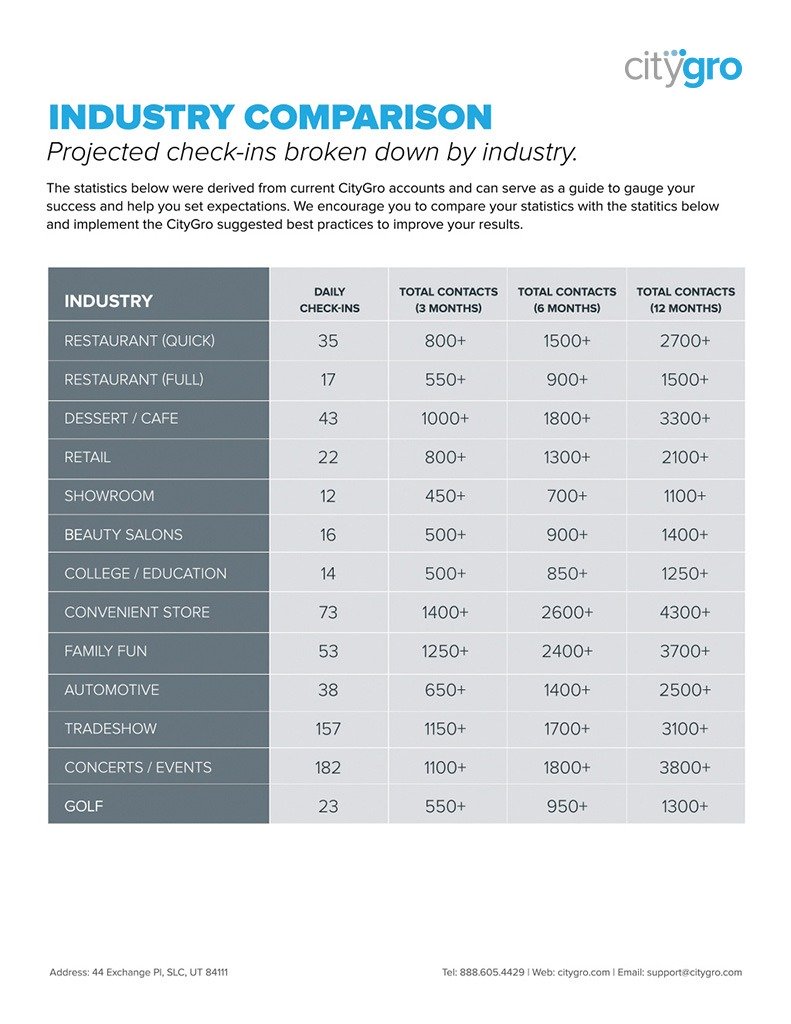Text Marketing Rules and Regulations
Did you know you can be fined anywhere from $500-$1,500 per unwanted text? If you are sending out thousands a month, you see how that can add up quickly. As long as you are following the text marketing rules and regulations, text marketing can be an extremely powerful tool for you. Above is a video that outlines the rules you need to be following to be compliant. You can also view the transcript below. You can also check out our blog post for more detail.
Text Marketing Rules and Regulations Transcript
Welcome everyone to facebook live here at CityGro. My name’s Eric. We have John Parish here, CEO of CityGro joining us today. Roles. Have a little bit of switched a little bit. Yeah. Great job on that intro. So excited to have John here. Um, today we’re going to be talking about texting rules and regulations. And just a reminder, if you have any questions, feel free to comment in the facebook live and we’ll answer those towards the end. But John Seems like you have a lot of knowledge about this and excited to go over it to do it a lot. Yeah, that’s right. Well, let’s, let’s dive right into it and just start out by asking, texting regulations in general what you bet. Well, we start with the disclaimer, the Fiat spot that we’re not, we’re not texted attorneys. However, we do come across a lot of regulation.
We look through what we stay up to date on it. Um, so, uh, we’re, we’re fairly educated. I think the goal today is really just to get that across in its simplest form A. Yeah. It seems like it might be kind of complicated. So complicated because there’s a lot of voices that seem to weigh in on regulations, but when you, when you kind of realize where those are coming from, they’re not all regulated voices, so hopefully will kind of clarify some of that today. Talk about who, uh, who actually will regulations actually matter and what, or maybe just some best practices and things like that. Well, let’s start there. Who actually regulated or who? Yeah. So, so let’s talk about a few different organizations. So I’m a, uh, the, the cellular telecommunications industry association. Um, I can’t see shit. I don’t know if they love that CTA Seasha.
So this is a. So this is not a government entity. They’re not out there writing the laws of the land that you can be sued over kind of the things. I guess you can be sued over anything. So. But they, they are, they are a significant voice in that they’re made up of. They’re in association made up of members from like the mobile agencies, the wireless carriers, all of those weigh in. And the reason they’re so powerful, they write regulations that if you don’t comply with, they’ll just shut you off. Right? So they can really damage your business if you don’t get sued over a mom by shutting off your short code, stopping you from communicating. Now with that said, they’re there. They’re actually really good about, I’m trying to make sure that you know what you’re doing and making sure you’re compliant. Things like that.
So, so that’s of the FCC. They’re, they’re an actual government entity. And I think that’s what most people think of when they think of tax. A lot of people probably think of them. Um, I mean when it really comes down to it, they’re the ones writing the laws and people have been sued. Companies have been sued a substantially for breaking FCC regulations. Gotcha. Um, so, so they are the ones that they’re really concerned about consent, whereas the CTA, they’re, they’re, uh, they put out a lot more documentation on what needs to be in your messages, what needs to be in your call to action a lot more just hands on. This is the verbiage we want. Gotcha. Where the FCC, they’re big on permissions. Did you get consent and why? What can you do with that content? And then there’s other groups, one I’ll mention is like the enemy than Mobile Marketing Association.
They don’t have power to turn off your system or a writing legal laws math, but they are a combined effort from very large companies or just big players in the mobile advertising space. And so they are a voice that gets heard quite often. Uh, put out a lot of best practices. This is what consumers like. This is what we’re slipping. It’s want to hear about a lot of those get defined as law where they’re not really law their best practices but still good ones to adhere to. So it sounds like there’s a few voices to be heard in this. Some of them are voices, humanities, others are more best practices we’ll probably talk about from here on out. Today is a CTA and FCC. OK. Those two regulations are ones that we, we adhere to. So. So yeah. Let’s talk about some of the actual regulations coming from KCC or ta.
What are some of the actual regulations that they discuss? Yeah. So, um, so the FCC A, they have a regulation that’s been in place since like 1991 TCPA. OK. A telephone protection act that the sec is really big, like I said, on consent. So what they did, they define it as prior express. Written consent were before you can market to anyone. You need to have their authorization. Now if you, if you break that up prior express written consent, it really tells you what they’re looking for. Written is a big thing I was going to ask that what, what does written me and how do you define race? So in it’s simplest form, you can get a waiver of signature that says, yes, I authorize my consent. However, there are a digital signatures available to, in fact, there’s an e-sign act is what it’s called, that’s referenced by the FCC that says it is OK to get consent via email.
Um, if the email saying their permission, um, website forums or web forms sold out online and putting it out and check the box. I’m the kiosk is used a lot by, he said, throw an application where you can sign up there. So basically if it can be stored and documented, it’s, it’s a written consent. But what about the common practice of keywords? Text, same thing. Yeah. Good question. So yes, a keyword opting into a keyword does count as consent and you can optimize list. Now to go to go along with that. There’s the express part a, there’s, you can’t, you can’t, ambiguous ambiguously get consent. People have to know what they’re consenting to say, hey, can I text you your receipt? And then Adam to your marketing list so they know what they’re signing up for it and know what they’re signing up for. And so Sisa comes in and they actually put in a lot more specifics on.
OK, on your call to action, there are certain things that we, we want you to put on there. You have to identify yourself and the, the, uh, the program that you’re opting into. You have to have terms and conditions on there or link to your terms and conditions, privacy policy that states that you’re not going to share this information that has to be on there and then you can’t share that information with other people and you have to put how often your sending messages and so in fact, this one, this one I see a lot where people will put like one to one the two messages a month or two to four minutes, which is a month. That’s one way to do it. You have to live by what you put. So, so does this where you’re talking about is this going in the actual message or is this just because they read actually puts a that they have regulations for both what?
So right now I’m talking about the call to action, which is like if you have a webpage that you getting sign ups or if you have a poster that displays a keyword test CityGro into the fine print of yeah, this is what actually goes on there. So your identity, your terms and conditions are links to your terms and conditions. Obviously if it’s print, you have to put some conditions on their privacy policy, you have to let them know that the data rates may apply. Messaging and data rates may apply, so there’s a whole list of them on our website which will give you directions to, but then there’s actual regulations for what goes in that first, what we call an in message in context. I sign up for a program and I do it through written consent. Maybe I signed up on on the website.
I put in my form. Well as soon as possible, they need to have an automatic message sent to me that says that confirms my consent in this message. I to have to explain how I am. You have to put your identity in it, so a business name or it has to be the same one that you signed up for. I cannot sign up for Joe’s diner and then get his sister companies. Actually messages has been the same one all throughout, so you have to have that in there and you have to have frequency. Once again, how often? They’ll have a lot so and that could be a very different ways. Our favorite is just putting a reoccurring messages, apply recurring messages, applying why, why is that your favorite and why do you leave for so that there is a nice component to saying two to four messages a month because people made me feel a little bit more comfortable saying, oh great.
By this time they’ve already opted in. I don’t think that that’s going to be a deterrent to opting out or it’s not going to really push them knocked out, so I just would rather not be boxed into how many messages I send to its best business practices already. Not to overspend, so this way if you just put recurring messages, you’re kind of covered so it still covers you, but it still covers, believes, leaves the doors open on what you do. Then you need directions on two different things. You need to start directions how to opt out. OK. There’s some universal keywords that you don’t have to display all of them in there. You can just display one of them, but by law your system has respond to a universal key words like stop and subscribe, quit. Those are all ones that if somebody replies, it pulls him out of the system and oxygen.
This is interesting. I see some people, they’ll respond to stop texting me like something like that to stop just having that word in there. Still it should. It needs to. In fact it specifically in the guidelines it says you can’t be different if it’s a capitalization or lower case or space to now the problem might come in and if you put two words together, but the system should recognize is the first word of that message. Stop. Those are universal words. That should be, and now the problem that comes in, if somebody replies, Hey, I moved, I moved to Africa, I know to will you please stop sending money. The system might not recognize that, but that’s why you just really make it clear to them. Reply Stopped, quit. That’s why the instructions, the instructions, they need to be both on that first message and they need to be in the conditions so they can be in there.
Um, there needs to be customer care information. They call it customer care. It can be as simple as a replay help for more information and basically how do I, if I want more information on this program that I don’t know if I opted in for where do I get it still can be a key word replay health. It could be a email support for more information, call this number to inflammation. And then the last thing, once again, just messaging and data rates apply. So that always needs to be all of that into one certain 60 characters, which is possible and there’s a lot of, in fact, if you go to our post, which you can either Google CityGro tax regulations or it’s in the footer on the blog post that we actually give you a nice clean way to put that. And you can switch out your name for it seems like there’s, there’s a lot there still room to put another message or if you’re clever, their candy and you can kind of mix them to like if a recurring one, if you want to say like you’ve opted into offers enough dates and just to let them know a little bit more that still counts or daily texts if it’s like a newsletter type thing and you can kind of kill two birds with one stone, get creative and you’re welcome to send us messages if you want us to look at it.
We do a lot of that for sure. So we’ve talked about a few things. We’ve talked about consent. What needs to be in the message, all that now along the lines of consent and having people actually opt in, is there ever a need for a double opt in or do they just often was double opt-ins a term that people have kind of clung onto and they define it as law? Well, part of it is, so let’s say, uh, once again in context that I go to a store and I want to be on their text program and they asked me at the counter, they say, hey, would you like to get texts about offers and updates? And I say, yes, please sign me up. Here’s my phone number. Well, they still don’t have written consent. Gotcha. So the text comes and it’s informational. So with regards to informational texts, now you can send that with just pre-authorized consent that doesn’t have to be written.
So that transactional informational, uh, thanks for coming in today type things. It can not have anything to do with marketing or promotions or that kind of thing. Simply like a receipt message, it can go out and then asked you reply. Yes. If you’d like to confirm texting offers. If you confirmed that you want to get texts and offer updates, reply yes or a keyword. That’s what’s called a double locked in. I opted in the first time by expressing it verbally. And then the second one is actually the written one. So that’s the only reason they needed it is not required. It’s optional in that same context. I went in, they had a kiosk on the counter and I put it on my phone number and click the box. Yes. I want to have him in that context. I don’t need a double opt in consent. So once you have written consent, you don’t need the double opt-in. It sounds like if you’re not doing written consent, verbal for transaction database or if it’s in any way unclear what they were opting in for, then you probably want to get the double consent that just, you know, just so you know, you’re opting into a promotions list where maybe you thought you were getting this one. Let’s just verify, clarify.
We’ve talked about a lot. I mean it seems like there’s a lot when it comes to rules and regulations, protects marketing, different things that go into it, but let’s say someone’s using text marketing but they may not be fully from client or light bulbs going off because they’re watching this facebook live. What happens is that, what do they need to do? So a couple things to consider, one is that a lot of people looking at our slide by because a, because maybe maybe at CTA compliant and I’m not too worried about my system getting shut off or you should be worried because there are actual fines that can come out as far as this is what best practices do come in and you don’t want to spend your customers, you want to be compliant, not just to be compliant, but because it’s actual best business practice, it will affect your business positively if you find that you’re not in compliance.
A couple of different sites, I want to get into compliance as fast as you can. Chances are, if you’re now a CityGro, whoever you’re with can help you get in there, if not, jump right? Find something that has, that makes it. The first thing to think about, uh, before you go through the whole checklist of is, are you getting pre written consent? If you are, you’re, you’re already doing really well. Just make sure you’re your language is correct. And now there are some, uh, there are some allowances for hiccups, right? Like, um, like in the case where somebody says, Hey, I went to, I moved to Africa, I can receive your message, please stop. And they opted out. The system didn’t recognize they opted out. Well. So let’s say that that person in Africa gets really mad. They suit you. What it’s going to come down to is what are your practices?
Do you have a practice of opt-in people out? Are you typically compliant? That’s what that’s hadn’t looked at. So just make sure you’re generally compliant if you have hiccups as fast as you can, there are some tolerances for that though. I wouldn’t say biggest takeaway, at least what I’m getting consent. Making sure you have consent. We’ve talked about some of the other compliance things, but yeah, like you mentioned just complaint as quick as you can if you’re not already exactly what it comes down to. Consent. Yeah. Perfect. Is there anything else regarding text regulations or rules that we haven’t covered that you’d like to cover? Just a couple of little ones that come to mind. Um, we talked about that initial text of what has to be in there. A lot of times we get asked, well, what has to be in there every time? Do I have to reply help to help get over time.
There’s only really two things that need to be in there. Every time your identity, you have to put that in their business name, your business name, but the same one they signed up for and then you do need at least monthly to remind them how to opt out so you don’t have to do it every time, but you do it monthly. I actually recommend that you do it as often as possible, if not every time. And why is that? Well, so it comes on from a text messaging provider because I want people to sending a lot of text messages. Yeah, for sure. However, from a business practice, I don’t. I mean, again, we’re not in the game of spam. If you can keep your list clean and it’s not just people that think you’re spam, it’s people that do move away or for whatever reason don’t apply anymore.
I remind them how to get out of your message. You won’t be paying for them anymore to receive messages, uh, even though it’s not expensive for them, but you have clean list that perform well. I would much rather have a slightly smaller list that performs really well than a really large list that doesn’t perform it all. But we’ve referenced a few different places as far as where you can find this information. Where’s the best place to find the information that we’ve gone over and regulations. Well, OK, so we mentioned a few. The TCPA, the telephone consumer protection act. That’s a, that’s a big one. It’s documented in that blog post I mentioned about and in fact there’s about 15 different places that are really refer to the same thing. The TCPA and then the guidelines put out from CTA. Those are the two documents that if you knew like the back of your hand, you would be compliant.
However we really abbreviate them. We’d give you the good note that needs to know in there and then we’ll link to them. So if you’re looking for those information, go there. It’ll save you a lot of googling and that can be found on our website, right site, both in the footer or you can them just google city geotechs regulations and it’ll be first of all list. Perfect. Well let’s see if we have any questions coming in on facebook live and then let’s see what we have. Was shocked that one for him. Do you ever get asked from from, uh, from your customers on the sales side if they need a port phone numbers over to another one if they’re switching providers for texting. So this is a big question and a concern for businesses because I’m not going to switch if I have to draw my entire list right?
I’ve already built up this huge list. So there is an appropriate way to port while you’re still on. So let’s say everything from a to b while you’re still on a, you let your customers know, hey, we’re switching to me. This will be the new phone number. And then when you get to be your, remind them, hey, this is our new, a number that’s coming from. And then remind them how to opt out. If they want to opt out. Cool. So last, last message from the old system, let them know you can change and that new system, I mean as best you can, keep that original documentation that they opted in and did so you have that consent. Cool. Well it doesn’t look like we have any questions coming in as of right now. Feel free to write in if you have any questions, we’ll get back to you as soon as possible. Thanks again, John for going over those rules and regulations and thanks guys for joining us today.






 Get this section from Jon. Get this section from Jon. Get this section from Jon. Get this section from Jon. Get this section from Jon. Get this section from Jon. Get this section from Jon. Get this section from Jon. Get this section from Jon.
Get this section from Jon. Get this section from Jon. Get this section from Jon. Get this section from Jon. Get this section from Jon. Get this section from Jon. Get this section from Jon. Get this section from Jon. Get this section from Jon.

